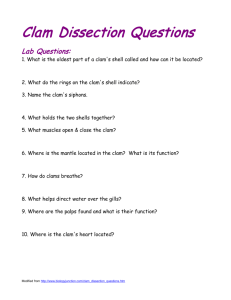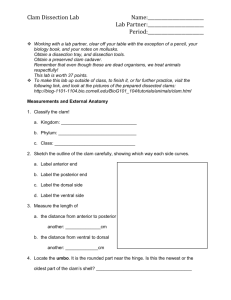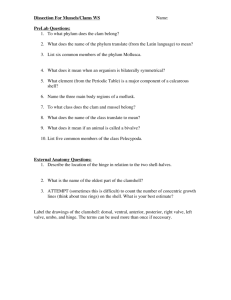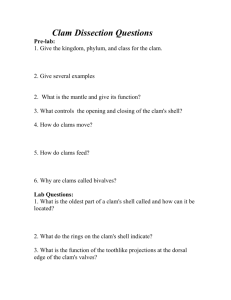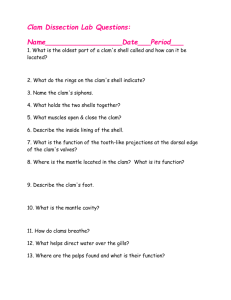ABSTRACT 1. INTRODUCTION Creating and managing large-scale software remains a
advertisement
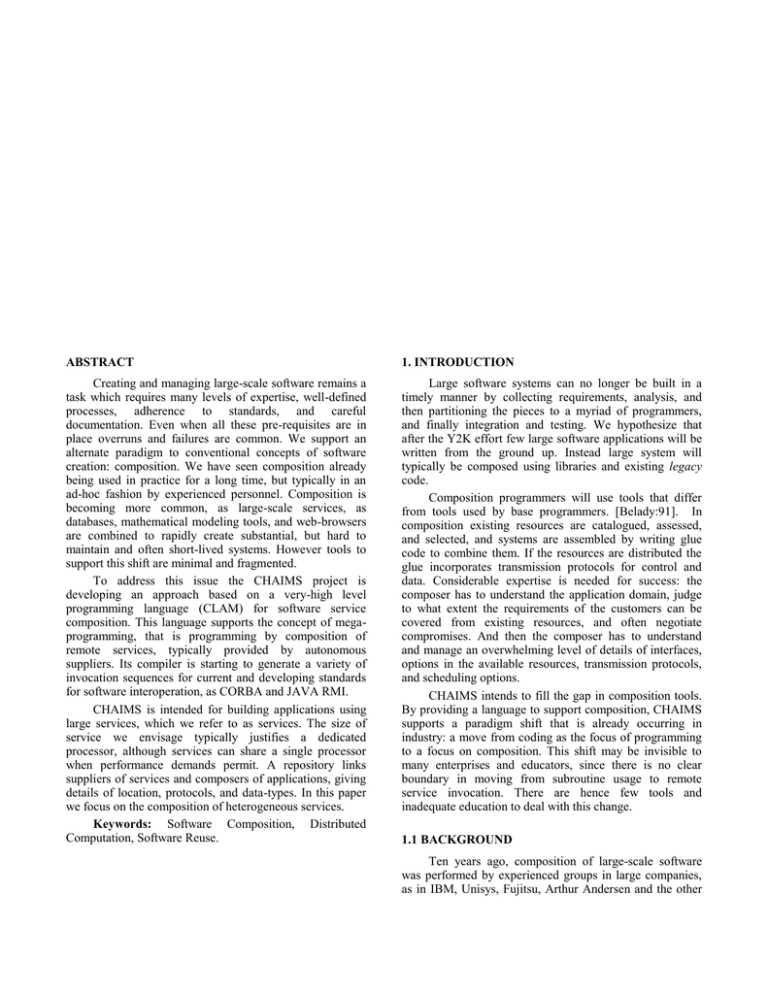
ABSTRACT
1. INTRODUCTION
Creating and managing large-scale software remains a
task which requires many levels of expertise, well-defined
processes, adherence to standards, and careful
documentation. Even when all these pre-requisites are in
place overruns and failures are common. We support an
alternate paradigm to conventional concepts of software
creation: composition. We have seen composition already
being used in practice for a long time, but typically in an
ad-hoc fashion by experienced personnel. Composition is
becoming more common, as large-scale services, as
databases, mathematical modeling tools, and web-browsers
are combined to rapidly create substantial, but hard to
maintain and often short-lived systems. However tools to
support this shift are minimal and fragmented.
To address this issue the CHAIMS project is
developing an approach based on a very-high level
programming language (CLAM) for software service
composition. This language supports the concept of megaprogramming, that is programming by composition of
remote services, typically provided by autonomous
suppliers. Its compiler is starting to generate a variety of
invocation sequences for current and developing standards
for software interoperation, as CORBA and JAVA RMI.
CHAIMS is intended for building applications using
large services, which we refer to as services. The size of
service we envisage typically justifies a dedicated
processor, although services can share a single processor
when performance demands permit. A repository links
suppliers of services and composers of applications, giving
details of location, protocols, and data-types. In this paper
we focus on the composition of heterogeneous services.
Keywords: Software Composition, Distributed
Computation, Software Reuse.
Large software systems can no longer be built in a
timely manner by collecting requirements, analysis, and
then partitioning the pieces to a myriad of programmers,
and finally integration and testing. We hypothesize that
after the Y2K effort few large software applications will be
written from the ground up. Instead large system will
typically be composed using libraries and existing legacy
code.
Composition programmers will use tools that differ
from tools used by base programmers. [Belady:91]. In
composition existing resources are catalogued, assessed,
and selected, and systems are assembled by writing glue
code to combine them. If the resources are distributed the
glue incorporates transmission protocols for control and
data. Considerable expertise is needed for success: the
composer has to understand the application domain, judge
to what extent the requirements of the customers can be
covered from existing resources, and often negotiate
compromises. And then the composer has to understand
and manage an overwhelming level of details of interfaces,
options in the available resources, transmission protocols,
and scheduling options.
CHAIMS intends to fill the gap in composition tools.
By providing a language to support composition, CHAIMS
supports a paradigm shift that is already occurring in
industry: a move from coding as the focus of programming
to a focus on composition. This shift may be invisible to
many enterprises and educators, since there is no clear
boundary in moving from subroutine usage to remote
service invocation. There are hence few tools and
inadequate education to deal with this change.
1.1 BACKGROUND
Ten years ago, composition of large-scale software
was performed by experienced groups in large companies,
as in IBM, Unisys, Fujitsu, Arthur Andersen and the other
`Big Five', and system contractors as SAIC, Lockheed,
MITRE, Lincoln Labs, etc. Today, software composition
has moved to UNIX and PC platforms, and an increasing
fraction of the software workforce is engaged in
composition, albeit without focused tools.
Several general-purpose programming languages have
had some composition facilities included within their basic
capabilities. Examples are the LEAP feature in SAIL,
services in PLITS, the Courier Protocol in Interlisp,
rendezvous in Ada, and tasks in PL/1 In the end, these
facilities were unwieldy and did not enter common usage.
The complexity introduced by these features may even have
contributed to their decay. Some information systems have
had extensions to manage distribution, as databases (SQL)
and some report generators.
1.2 ARCHITECTURE
The components of CHAIMS are symbolically
depicted in Fig. 1. The topmost component is the client,
represented by a program that defines the composition. The
client program only manages the invocation of the services,
according to precedence constraints that typically represent
dataflow dependencies. The client program is compiled by
the CHAIMS compiler [PerrochonWB:97]. The resulting
executable runtime program consists mainly of service
invocations, expressed using the interface standard
protocols that are appropriate for this service. Many of
these invocations will involve remote accesses, since we
assume that the services reside on multiple sites, connected
by a communication network. Any needed datatype or
computational conversions to be performed in the dataflow
are invoked externally to the client program, assuring that
the client program is a clean representation of the
architectural intent for this application. The actual services
are either pre-existing and wrapped to serve CHAIMS
primitives or written to order in a suitable programming
language.
1.3 OBJECTIVES
We observe that large-scale composition requires
functionalities not available in current mainstream
programming languages. Connections to remote sites have
to be set-up, scheduling of computations that can operate
on parallel has to be managed, data have to be shipped
among programs that are written in diverse languages, and
a variety of transmission protocols have to be managed.
1. By defining a high-level language (CLAM) in
which an application specialist can compose resources, we
expect that the issues involved in composition will be
clarified. By actually having a compiler for the language,
we are able to test and assess the concepts needed.
2. To support the composition concept we need to
define a protocol for communication that can be driven
from a high-level language. To broaden the range of
resources, our CPAM protocol can access services using
any of a variety of existing interoperation standards,
exploiting ongoing work in client-server technology.
Linking to actual remote computational resources we can
demonstrate the concepts to a broad audience and provide
guidelines to deal with this paradigm change.
3. We also have to consider the roles that people play
at the various layers of the system. In common with any
large-scale organization we must recognize specialized
roles. These roles are seen to be long term, since the largescale software will also be long-lived, so that adaptation
and maintenance is more important than the initial creation
of a system.
The CHAIMS project has a limited scope: there is no
plan for automatic programming, CLAM supports only a
few data types, and the CHAIMS environment uses many
defaults rather than give the programmer a rich palette of
choices in the invocation of software services. By focusing
CHAIMS on interoperation in a multi-site environment,
rather than on platform-specific code, we gain high-level
support of megaprogramming concepts.
We will now now deal with these three issues in turn.
2. LANGUAGE
The CHAIMS megaprogramming language serves
only service composition and scheduling. Its narrow focus
should allow it to remain simple, although some significant
new concepts are introduced. By isolating the concepts
related to composition and thus reducing our conceptual
scope, we can address the specific issues within a research
project of modest size.
Since CHAIMS does not provide for automatic
programming or knowledge-based techniques, the
composer must know which services offer what
functionality and must have access to a well-maintained
CHAIMS repository. The process of CHAIMS client
program generation and use is illustrated in Fig. 2. The
composer builds the source code of the client program in
the composition environment. During that process the
programmer will access service descriptions in the
repository and also obtain initial feedback from the
CHAIMS compiler.
2.1 PRIMITIVES
The statements in the CHAIMS language fall into
three categories:
1.
Initialization and termination statements, which
control connections to the services: SETUP,
GETPARAM, SETPARAM, TERMINATE, and
TERMINATEALL
2.
Service invocation statements, which cause
processing results or intermediate results for control
to be generated: INVOKE, ESTIMATE, EXAMINE,
and EXTRACT
3.
Statements to control the flow of the client program:
WHILE, IF .. THEN .., ELSE..
The specific functions of these statements are
sketched in Section 3.1, and an illustration of a simple
program written in CLAM is given in Figure 3. CLAM
places some logical and data dependency constraints on the
execution sequence of these primitives. The major logical
constraint is that each service being invoked requires a
SETUP. An identifier generated by SETUP is used for all
subsequent accesses to this service. INVOKE, starting the
execution of a service method, also generates an identifier,
and that identifier is needed for EXAMINE and EXTRACT
statements to check and return results.
The services being invoked are autonomous and
independent from each other, but must individually support
the CHAIMS protocol, CPAM. This allows suppliers to
develop new services, to be easily accessed by CHAIMS
programs. Such services can be programmed in the most
suitable language and use the best representation for the
given sub-task and solution approach. However, in the
beginning there will be little compliant software available,
so that we provide wrapper templates for legacy software to
satisfy CPAM.
CLAM supports only a few datatypes, for two distinct
functions:
1. For control of flow CLAM supports identifiers,
integers, boolean, real, string, and a date type. The
identifier type provides the handles needed for services
and service invocations. Computations on the other
types are performed using a CHAIMS supplied native
service module. This module follows JAVA standards.
2. For processing data CLAM supports a bag, which
holds a complex object type, using the ASN.1
standard. The CLAM program cannot discern the
content of a bag, it can only move it between services,
including native services for input and output.
The native service modules, supplied with the
CHAIMS system, appear identical to remote service
modules, so that their behavior can be replaced. Such
replacements may be needed if the client program lives in
an unusual environment, say an embedded system.
The ASN.1 standard supports a recursive data structure
of triplets, where each data element consists of a
descriptive name, type information and a value. The value
is either again a triplet or a simple type, like bit-map, array
of bytes, date-time, string, real etc. The wrappers convert
this general object format into the local service formats.
The CHAIMS compiler is not burdened with having to
deal with many types, any type conversions, or with code
for fancy end user input/output. Interaction with the
customer running the client program is dealt with through
the native or substituted input/output services.
The binding of client programs to services can be
delayed arbitrarily, and changed later by recompilation of
the CHAIMS program. Delayed binding simplifies
maintenance, adaptation to changing network conditions,
and changes in service capabilities and costs. Delayed
binding also relaxes commitments to specific interface
standards. Choices among standard interfaces as CORBA,
ActiveX, JavaBeans, and DCE can be deferred until the
scale of the problem being addressed is known and the
platform capabilities can be assessed. Even new interface
standards can easily be adapted by updating the compiler,
its library and recompilation of existing CHAIMS client
programs.
2.2 CLARITY
The structure of a client program defines the
architecture of a system, independent of its implementation.
In effect, the model architecture will be clearly visible, and
is not buried in interface and application-specific code. The
client program defines an architectural instance of an
application, while delegating all computational activities to
the services it invokes. The architecture instance defined in
a client program is reusable, not as a paper document, but
when linked and recompiled with appropriate services, as a
complete re-instantiation of the domain architecture. Since
the compilation can bind to alternate interface specification
languages and to alternate services, scalability and platform
independence can be achieved, as long as equally
competent services can be acquired. The client program
will be limited by the capabilities of current interface
languages, but these are improving rapidly.
We intend to provide a graphic editor to manage a
graphic description of the client program's architecture.
Here we do not need to be novel. Many tools for graphic
displays of computer architectures are available today,
although they may not drive actual system execution. Any
reasoning tools they provide can provide assistance of
course, although we hope that the client programs will
remain of modest size, and CLAM discourages complexity.
Final validation of a CHAIMS architecture instance is
through its execution, including the execution of the client
program in smaller environments.
2.3 PARALLEL COMPUTATION
Modeling the activity of real world objects, parallel
operation of the services is the underlying assumption in
CHAIMS. This vision means that the increasing availability
of distributed computing can be exploited without resorting
to parallel computing features applied to sequential
programming languages. By considering any sequential
dependency as an exceptional constraint, the composer will
naturally think of parallel execution. This concept of
natural parallelism is the alternative to the common
paradigm seen today, where the programmer codes the
actions to be performed in a world where everything lives
in parallel into a sequential format, which is subsequently
analyzed by parallelization tools to extract possibilities for
parallel execution. Since activities in a natural, distributed
world actually occur in parallel, we hope that CHAIMS
client programs can capture their essential parallelism
without dual translations.
CLAM achieves new flexibility in service scheduling
by having split the functions of the traditional CALL
statement into units that can be scheduled independently:
SETUP, INVOKE, and EXTRACT. The ESTIMATE and
EXAMINE statements, described in more detail below,
provide the information needed for their scheduling. In
addition to exploiting parallel execution of services, the
communication bandwidth requirement among them can
also be significantly reduced. Documentation of the
optimizations will be covered in future papers.
2.4 SUMMARY
The focus of the megaprogramming language CLAM
and the CHAIMS interface drivers is to reduce the cost of
long-term maintenance and software evolution, and reduce
the numbers of errors occurring in this process, without
reducing the extent of maintenance and evolution actually
being performed. Since CLAM only serves service
composition and scheduling, client programs remain
relatively simple, although efficient distributed computation
is supported.
3. INVOCATION PROTOCOL CPAM
CPAM (CHAIMS Protocol for Autonomous Services)
is our protocol for accessing and using the methods offered
by services. Services are offering their services independent
of a specific client. A client does not have to own a service,
it just can use remote services, offered as methods to be
invoked. The effect is that CPAM allows process
composition.
CPAM has characteristics that address specifically the
composition and reuse of autonomous, mostly distributed
and computation intensive services [BeringerWL:98].
Having distinctive calls allows for the client to be simple
while exploiting the parallelism of methods invoked from
different services. We will briefly describe the CPAM
primitives, and then explain the benefits of their separation.
3.1 CPAM PRIMITIVES
We briefly summarize the primitives here, more detail
is provided in [SampleBMW:99].
Establishing a connection to a service: The
primitives SETUP and TERMINATEALL establish and
end the connection of a client to a service.
Cost estimation: ESTIMATE allows a client to ask a
service for cost estimates for a specific method. It is
available prior and during execution. The output is to be a
name-tuple list (name of the cost factor, value of the cost
factor and its uncertainty). If the service cannot provide
estimates, its wrapper returns as reasonable values as
possible, perhaps based on past executions. Cost estimates
allow the composer or a CLAM optimizer to choose among
alternative services and/or optimal execution paths.
Executing service methods: Methods are executed
by the following four calls: INVOKE, EXAMINE,
EXTRACT and TERMINATE. INVOKE starts the
execution of a method, which then proceeds
asynchronously, multiple INVOKES with different
parameters can occur within a SETUP. EXAMINE reports
the status of the execution, EXTRACT returns selected
results, and TERMINATE deletes the invocation, but does
not disable access to the service.
Presetting of attributes: The call SETPARAM is
used to set default values for invocation attributes and
global variables in a client-specific way. The
complementary call GETPARAM simply allows checking
of default values in a service or values set by SETPARAM.
3.2 CPAM EXECUTION ALTERNATIVES
Figure 4 shows the paths of execution that are possible
with a single service, and an arbitrary number of such paths
can be interleaved. The protocol allows exploitation of a
variety of conditions with a single scheme:
1. As expected, multiple services can be SETUP in
parallel, and their invocations interleaved. If useful, a
single service can be SETUP multiple times, for
alternate conditions.
2. SETUPs can be performed early and in parallel, so that
subsequent data-constrained sequential INVOKEs can
be rapidly executed. In many distributed computations
SETUP can take more time than method invocation.
3. EXAMINE permits traditional polling prior to
EXTRACT, allowing the client to overlap execution of
INVOKES. Nothing novel here, but
4. EXAMINE can return progress indications from
simulations and similar long-running or continuous
executions (say weather predictions), so that the client
can balance precision and result delivery time.
5. Multiple INVOKES to a service method can be made
in parallel, typically with differing input parameters for
the service, for instance to bracket a range of decision
parameters.
6. A high uncertainty of costs of alternate optimization
choices during compiling can be resolved by moving
the ESTIMATE statement into the execution flow,
when the values should have a lower variance.
7. ESTIMATE can be used to decide on scheduling or
canceling of alternative services.
8. ESTIMATE can be used to make choices among
service execution orderings, especially when preexecution compilation can not resolve significant
uncertainties.
9. EXTRACT can specify a few control values to be
reported, to let the client program decide if a
satisfactory solution has been obtained or more
iterations of INVOKE with new input parameters are
necessary.
10. Dynamic services can be interrogated using
GETPARAM.
Many of these alternatives exist now somewhere, either
as a feature of a specific programming system or through
clever programming of an application. We do not know
any approach which has provided the mix-and-match
capability show in the CPAM protocol.
utilizing networks and a variety of services. These systems
represent major investments, and have a long lifetime.
3.3 INTEROPERATION PROTOCOLS
4. ROLE ASSIGNMENT
CPAM is a protocol which is mapped by CHAIMS
onto a variety of existing client-server protocols. We have
used CORBA, JAVA RMI, DCI, and DCOM with various
degrees of success and happiness. The strength of CPAM
is however the flexibility of interface standard choice,
changeable at any time by client program recompilation.
The size of the services we envision typically justifies
a dedicated processor, although services can share a single
processor when performance demands are modest. Services
written in C, C++, Ada, FORTRAN, etc., will need
interfaces (similar to APIs) to allow interoperation in the
CHAIMS setting. Interoperation protocols from standards
as CORBA, ActiveX, JavaBeans and DCE provide, in
effect, our machine languages and make the CHAIMS
concept implementable today. We believe we can succeed
because we can build on these efforts being expended on
interfaces for interoperation within client-server models. By
moving up one level of abstraction in programming, we are
moving to a new paradigm where the focus is on
composition of services, rather than assembly of code.
In a megaprogramming environment we distinguish
two primary divisions, namely the servers and the clients
roles. One application system is likely to use multiple
servers, but be controlled by one client. Other clients can be
composed of the same and other services. Figure 5 shows
the main components of an instance of a CHAIMS system.
The repository provides the means for sharing information
about all the available services, and links supplier,
composer, and end-user.
3.4 ADAPTABILITY TO CHANGING STANDARDS
The move to composed software is clear, but still
poorly focused. We now have as many proposed standards
for software interoperation as we had computer hardware
architectures thirty years ago. Modern programming
languages now provide platform independence and
programs can be recompiled for new hardware. The effect
is that application software typically lives about 15 years,
much longer than its hardware.
The same stability does not exist yet for interface
software, especially when connecting computers of
different types. For instance, SQL is undergoing changes in
its transition to SQL-2 and -3. Selection and
implementations of feature sets will vary widely. OMG's
CORBA 2 will have many features not available in
CORBA. KQML concepts are being suggested for future
versions of CORBA , while JAVA is taking over servermanaged client computing. The intent of XML is to
replace HTML for processing applications, but will depend
on an unknown variety of DTD definitions to achieve depth
at the cost of consistency. New object-libraries arise, but
are rarely compatible with those of other suppliers. We
must surmise that interfaces for distributed computing are
likely to stay fluid.
Just as traditional programming languages provide an
insulation from platform differences, the essence of
CHAIMS is to provide insulation for the composer from the
differences in today's interoperation architectures and
standards. Such independence is especially crucial for
larger systems which need to operate on multiple sites,
4.1 SERVICES
The concept of services implies autonomous
ownership. The control over the component or service
remains at the provider's site. This is a major distinction
with traditional software models, where components or
services, no matter how large, are subservient to the calling
routine. A prime example of services today is provided by
databases, but there are also some computational services
available today. The Internet provides a wide variety of
services, although they are rarely envisaged for
composition, examples include weather services, airline
ticketing, and book sales. Other potential services are
simulation programs, design and construction programs,
services for genomics [GennariCAM:98] [Searls:98] and
for manufacturing [CramsieEa:97], business services
[Oracle98]. Many more are expected to come into
existence. But there exist yet few protocols supporting an
integrated vision and allowing easy reuse and composition
into a larger system.
The economics of a service are based on reuse. It
becomes a benefit to the service provider to maintain the
service. The rules and processes encoded in a service
represent knowledge. This knowledge is subject to change,
not just the data it operates on. As the world changes,
recourses broaden and algorithms improve. Bringing this
updated knowledge to the client, either by reusable
components or as updated concepts and requirements to be
integrated and implemented by the customer into their
programs, is cumbersome. Legal issues for service
providers have been analyzed by [ChavezTW:98].
Time and fee can be estimated by the service, and can
then be directly taken into account when calculating the
cost of using a certain method. This is not true for the third
cost factor. Though the amount of data flow can be
estimated by the service, the effective cost is not the
amount of data but the time the data needs to be transferred.
This time is client specific because it not only depends on
the amount of data but also on the capacity of the
connection, i.e., quality of connections, distance, and traffic
volume.
Note that for client process optimization a high
precision in estimation is not crucial. The scheduling
alternatives tend to be limited, and if the choices are close
in costs, then the choice does not even matter. Variance is
more of an issue, since a high variance means that more
choices must be deferred to execution time.
4.2 COMPOSITION
The programmer who writes the client programs
becomes a composer of services. The composer’s tools are
knowledge of an application domain, an understanding of
services at a high level, the specific interface information
captured in the repository, the CLAM compiler, and the
wrapper templates [BeringerTJW:98]. The repository is
currently a simple text file with a graphical browser. It
contains a description of all available services, their
methods, and their attributes. All the valid service, method
and attribute names are posted in the repository. The
repository is the only formal information flow necessary
between providers, composers, the end-users or customers
using the client programs, the compiler, and other tools in
CHAIMS. The compiler compiles a client program written
in the composition language CLAM into a client side runtime (CSRT), including the generation and compilation of
all necessary stubs for various distribution systems. The
wrapper templates are provided as part of the CHAIMS
system to facilitate the wrapping of legacy services into
CPAM compliant services.
The composition language CLAM together with the
CHAIMS system disengages the domain experts from
technical details like the use of complex programming
languages and the programming of distribution systems.
This can be compared to today’s use of database
management systems, where the SQL programmers are
quite distinct from the programmers who work at the
DBMS provider, and it is unlikely that they have ever met.
We hence assume that these two roles are occupied by
different persons with differing skills and objectives.
CHAIMS should make it easier to train domain
specialists in composition rather than untrain conventional
programmers that are used to all forms of restrictions. We
still have to learn to what extent CLAM should not be
similar to an existing sequential programming language, so
that it will be clear to the composer that the environment is
inherently parallel, and that much prior experience and
training will have to be unlearned.
4.3 APPLICATION CUSTOMERS
The customers of the client-programs live in the same
domain as the composers, so that interaction is easy, and
adaptation to changing customers need is rapid. If the
customer is technically confident, and the tools are reliable,
the customer and the composer may be the same person.
When new services are required, searches through the
repositories are the first task. If no suitable service is
found, then wrapping of a legacy service has to be
negotiated.
The focus of CHAIMS is mainly on computational
services, complementing the now dominant information
services. Especially in the domain of web-information,
information is downloaded from an information server, and
then put manually (cut and paste plus maybe some
cumbersome conversions) into another program that
performs actual processing, say, a spreadsheet. Our
demonstrations have focused on logistics and scheduling
applications, since in that area suppliers of transport,
warehousing, and breakdown services have a motivation to
provide assistance to their customers, while the customers
have many choices to assemble these services. Our case
studies include a logistics example ("find the best route
from city A to city B under certain circumstances") using
several services for the various parts of the computation,
and an aircraft design example with services for the
computation of the structure, the control elements and the
static of an aircraft wing.
5. CONCLUSIONS
We described a tool that supports a non-traditional,
but realistic approach to software systems development.
Rather than following the waterfall model or its variations
by starting from specifications, through design, etc. to code
generation, CHAIMS assumes that large programs can best
compose from existing services. This limits the application
client programs to the composition of available resources,
or Megaprogramming [BoehmS:92]. The benefits of the
approach are largely in terms of long-term maintenance of
computer systems, which consume 70-90% of total systems
costs.
In a megaprogramming approach, composers are
willing to give up control for the benefit of expert
maintenance at the source sites in a collaborative setting
[WiederholdWC:92]. Megaprogramming distinguishes
itself from database integration by incorporating knowledge
embedded in programs, rather than being limited to
declarative knowledge applied to databases. Database
functionality can be incorporated into megaprogramming
through server programs that execute SQL SELECT
statements, but these languages - focusing on a single verb are known to have inherently limited computational
capabilities [Ullman:88].
Megaprogramming can also be viewed as large-scale
object-oriented (OO) technology. OO increases the
procedural capabilities of distributed objects [Booch:91],
but is restricted in practice to single protocols and coherent
libraries [AtkinsonBM:95]. The high-level language
approach of CHAIMS scales the object-oriented paradigm
to autonomous service objects.
ACKNOWLEDGMENTS
The concepts we have assembled at a high level have
their origins in much related work. In this brief note we
cannot cite all of them, but we wish to acknowledge them.
Specific references are given in other papers describing our
REFERENCES
[AtkinsonBM:95] M.P. Atkinson, V. Benzaken, and D.
Maier (eds.): Persistent Object Systems: Springer-Verlag
and British Computer Society, 1995.
[Belady:91] Laszlo A. Belady: "From Software
Engineering to Knowledge Engineering: The Shape of
the Software Industry in the 1990's"; International
Journal of Software Engineering and Knowledge
Engineering, Vol.1 No.1, 1991.
[BeringerTJW:98].
Dorothea
Beringer,
Catherine
Tornabene, Pankaj Jain, Gio Wiederhold: "A Language
and System for Composing Autonomous, Heterogeneous
and Distributed Megamodules"; Proc. of Data and
Expert Systems (DEXA) Software Composition
Workshop, IEEE, August 1998, p.826-833.
[BeringerWL:98] Dorothea Beringer, Gio Wiederhold,
Laurence Melloul: "A Reuse and Composition Protocol
for Services"; Proc. Symp. on Software Reusability
(SSR'99), ACM SIGSOFT, Los Angeles CA, May 1999.
[BoehmS:92]
B.
Boehm
and
B.
Scherlis:
"Megaprogramming";
Proc.
DARPA
Software
Technology Conference 1992, Los Angeles CA, April
28-30, Meridien Corp., Arlington VA 1992, pp 68-82.
[Booch:91], [Booch:94] Grady Booch: Object-Oriented
Design with Applications, 2nd Ed.; Benjamin-Cummins,
1994.
[ChavezTW:98] Andra Chavez, Catherine Tornabene, and
Gio Wiederhold: "Software Component Licensing Issues:
A Primer"; IEEE Software, Vol.15 No.5, Sept-Oct 1998,
pp.47-52.
[CramsieEa:97] Bill Cramsie et al: CIIMPLEX Reference
Architecture; Consortium for Integrated Manufacturing
Protocols (CIIMPLEX), Atlanta GA
[GennariCAM:98] J. H. Gennari, H. Cheng, R. B. Altman,
& M. A. Musen: ”Reuse, CORBA, and KnowledgeBased Systems”; Int. J. Human-Computer Sys., Vol.49
No.4, pp.523-546, 1998..
[Oracle98] "Oracle Business OnLine, Removing Barriers to
Enterprise
Applications
Adoption",
http://www.oracle.com/businessonline/,
Oracle
Corporation, 1998.
[PerrochonWB:97] Louis Perrochon, Gio Wiederhold, and
Ron Burback: "A Compiler for Composition: CHAIMS";
Fifth International Symposium on Assessment of
Software Tools and Technologies (SAST97), Pittsburgh,
3-5 June, IEEE Computer Society, 1997, pages 44-51.
[SampleBMW:99]. Neal Sample, Dorothea Beringer,
Laurence Melloul, and Gio Wiederhold: "CLAM:
Composition Language for Autonomous Megamodules";
Third International Conference on Coordination Models
and
Languages
(Coord99),
Amsterdam,
The
Netherlands, April 1999, to be published in a Springer
LNCS volume.
[Searls:98]David Searls; “Biowidgets”; Computational
Methods in Molecular Biology, Elsevier Science, 1998.
[Swenson98]
Keith Swenson, "Simple Workflow
Access Protocol (SWAP)", Internet-Draft submitted to
WfMC (Workflow Management Coalition), available at
http://www.ics.uci.edu/pub/ietf/swap/
[Ullman:88] J. D. Ullman: Principles of Database and
Knowledge-Base Systems; Volume 1: Classical
Database Systems, Computer Science Press, 1988.
[WiederholdWC:92] Wiederhold, P. Wegner and S. Ceri:
"Towards Megaprogramming: A Paradigm for
Component-Based Programming"; Communications of
the ACM, 1992(11): p.89-99.
FIGURES
Client program for composition,
written by domain specialist
(:
research. Motivation for the work was also provided by a
business school study into modern software practices. The
development of client-server protocols, and problems seen
in the maintenance of these system provided additional
motivation and insights.
The CHAIMS project is supported by DARPA order
D884 under the ISO EDCS program, with the Rome
Laboratories being the managing agent and by Siemens
Corporate Research, Princeton, NJ. We thank Mehul
Bastawala, Ron Burback, Jing Chen, Joshua Hui, Pankaj
Jain, Wayne Lim, Lawrence Lo, Louis Perrochon, Woody
Pollack, Gregory Rokita, Kumaran Santhanam, Guido
Schryen, Catherine Tornabene, and Felix Yu for their
earlier contributions to the CHAIMS project.
CHAIMS
Compiler & templates automate
generation of client code for
distributed system
Transport protocols
access services
Services
Services & Interfaces
provided by various
suppliers
Fig. 1 Components of the CHAIMS megaprogramming
paradigm
Pre-invocation:
customer
composer
SETUP
Client-program
Text
Service / platform
descriptions
SET-, GETPARAM
ESTIMATE
CHAIMS
compiler
Feedback
Invocation and result gathering:
INVOKE
Compliant Service
EXAMINE
Wrapper / API
Legacy Wrapper
Service / API
to be composed
Modules
to be/ API
Wrapper
composed
Legacy Service
to be composed
EXTRACT
IO
module
Client
program
Termination:
TERMINATE
Transport
mechanisms
TERMINATEALL
Fig. 2 The CHAIMS megaprogramming process and
information flow
Fig. 4 Sequencing of CPAM primitives
BEGINCHAIMS
io = SETUP("io")
math = SETUP("MathMM")
am = SETUP("AirMM")
gm = SETUP("GroundMM")
// Get source and destination cities
ioask = io.INVOKE("ask", label="which cities")
WHILE(ioask.EXAMINE() != DONE) {}
(cities_var = Cities) = ioask.EXTRACT()
// Calculate costs of the route by air, and
// by ground, in parallel
acost = am.INVOKE("GetAirTravelCost",
CityPair = cities_var)
gcost = gm.INVOKE("GetGdTravelCost",
CityPair = cities_var)
// Make other invocations (e.g., Check weather)
….
// Extract the two cost results
WHILE(acost.EXAMINE() != DONE) {}
(ac_var = Cost) = acost.EXTRACT()
WHILE(gcost.EXAMINE() != DONE) {}
(gc_var = Cost) = gcost.EXTRACT()
// Compare the two costs
lt = math.INVOKE("LessThan", value1=ac_var,
value2=gc_var)
WHILE (lt.EXAMINE() != DONE) {}
(lt_bool = Result) = lt_ih.EXTRACT()
// Display the smallest cost
IF (lt_bool == TRUE) THEN
{ iowrite = io.INVOKE("write", data = ac_var) }
ELSE
{ iowrite = io.INVOKE("write", data = gc_var) }
am.TERMINATE()
gm.TERMINATE()
io.TERMINATE()
math.TERMINATE()
ENDCHAIMS
Fig. 3 CLAM program to calculate the
best route between two cities
Composer
(Domain Expert)
Service
supplier
EndUser
Repository
writes
Megaprogram
(written in CLAM)
Wrapper
templates
CHAIMS
Compiler
generates
CSRT (client)
Service
modules
IO module(s)
CPAM protocol
bbb
Distribution System (CORBA, RMI…)
Fig. 5 Overview of the CHAIMS system

